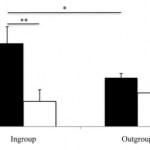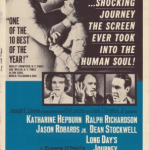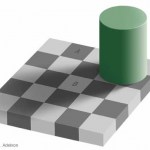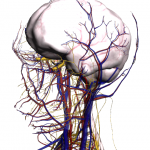neuroscience
Wow - my post about unhappy bio grad students is getting massive traffic. (Hi SlashDotters and StumbleUpon-ers!) Mike the Mad Biologist, my original inspiration, has responded here and here to all the buzz.
I pretty much said everything I wanted to say in the original post, and I don't pretend to have an explanation or cure for this problem. But I see that there's been some snarkiness on the intertubez (shocking!!!) while I was away watching the developments in the Myriad appeal. So I want to clarify two points.
First, let me emphasize that I'm not saying graduate students in other fields don…
You know that old phrase, "monkey see, monkey do"? Well, there might be something to it, except that chimpanzees aren't monkeys. (Sadly, "ape see, ape do" just doesn't have the same ring to it.) A new paper published today in PLoS ONE has found evidence that chimpanzees have contagious yawning - that is, they can "catch" yawns from watching other chimpanzees yawning - but (and here's the interesting part) only when the chimp that they're watching is a friend.
At first, scientists thought that contagious yawning was the result of a releasing mechanism - in other words, seeing someone yawn…
THE human gut contains a diverse community of bacteria which colonize the large intestine in the days following birth and vastly outnumber our own cells. These intestinal microflora constitute a virtual organ within an organ and influence many bodily functions. Among other things, they aid in the uptake and metabolism of nutrients, modulate the inflammatory response to infection, and protect the gut from other, harmful micro-organisms. A new study by researchers at McMaster University in Hamilton, Ontario now suggests that gut bacteria may also influence behaviour and cognitive processes such…
The federal government, including NIH, isn't exactly seen as a hotbed of artsy drama types. ("Faceless gray mega-bureaucracy" might be a more typical descriptor.) So I was tickled to learn that the National Institute on Drug Abuse is framing a series of continuing medical education (CME) courses about addiction around dramatic readings of Eugene O'Neill's Long Day's Journey Into Night. And no, we're not talking about cheesy readers' theater - they got Debra Winger and several Tony nominated stage actors to participate.
As a threshold matter, this is cool because it shows that NIH recognizes…
I guess it's not surprising, my dopamine is rising
And my glutamate receptors are all shot
I'd surely be bemoaning all the extra serotonin
But my judgement is impaired and my confidence is not
Allosteric modulation
No Long Term Potentiation
Hastens my inebriation
Give me a beer. . .
Physiology professors, I trust you know what to do with this holiday treasure by cadamole. Nothing makes neurobiology seem relevant like a beer.

The Cyclotrope from tim Wheatley on Vimeo.
The cyclotrope is a cycle of 18 images that is spun at a certain speed so that the frame rate of the camera filming it gives the illusion of animation.
A humble suggestion to high school art/science/media teachers: if your curriculum is not already too constrained by standards and tests, there are near-infinite possibilities in a bicycle wheel, a camera, and art. . . think Muybridge.
I visited Vilayanur S. Ramachandran's lab at the University of California, San Diego recently, and interviewed him and several members of his lab about their work. Rama and I talked, among other things, about the controversial broken mirror hypothesis, which he and others independently proposed in the early 1990s as an explanation for autism. I've written a short article about it for the Simons Foundation Autism Research Initiative (SFARI), and the transcript of that part of the interview is below. I also wrote an article summarizing the latest findings about the molecular genetics of autism…
Welcome to the second installment of Animal Territoriality Week. Today, we'll look at a case where differences in territory size can have implications for neuroanatomy. If you missed part 1 of Animal Territoriality week, check it out here.
Let's say you have two very very closely related species. You might even call them congeneric, because they are from the same taxonomic genus. In most ways, these two species are very similar, but they differ behaviorally in some very big ways. Might those behavioral differences predict neurobiological differences?
The different species of the genus…
EVERY year, hundreds of thousands of people suffer from paralyzed limbs as a result of peripheral nerve injury. Recently, implantation of artificial nerve grafts has become the method of choice for repairing damaged peripheral nerves. Grafts can lead to some degree of functional recovery when a short segment of nerve is damaged. But they are of little use when it comes to regenerating nerves over distances greater than a few millimeters, and such injuries therefore often lead to permanent paralysis.
Now though, surgeons from Germany have made what could be a significant advance in…
LOOK at the photograph on the right. Does it show the face of a man or a woman? There's no right answer - the photo has been manipulated to look sexually ambiguous and can be perceived as either. But according to a recent study published in the journal Psychological Science, the sense of touch can influence how you perceive and categorize the face.
Last year a team of European psychologists found that bodily movements alter the recollection of emotional memories, and an American group showed that the sense of touch influences social judgements and decisions. The new study adds to the growing…
Deservedly or not, jocks have a reputation for being less cerebral than beaker jockeys and bookworms. But when it comes to American football, brain damage can be all in a day's work. On The Pump Handle, Liz Borkowski highlights a recent article by Ben McGrath in the New Yorker, addressing "the effects of repeated brain trauma, which football players often experience during games and practice alike." Even if a player walks off the field, repeated brain-rattlings can lead to dementia and other long-term health problems. But thanks to journalists like Ben, the NFL is starting to pay…
There's a great blog called ionpsych being run by Dan Simons (of Invisible Gorilla fame). The posts are all by graduate students in a science writing for public consumption class. I'm glad people are starting to teach us overly technical scientists how to communicate in graduate school. I'm not aware of any other class out there dedicated to teaching psychology and neuroscience students how to best communicate their ideas to the world.
Anyway, here's one of my favorite posts from Audrey Lustig:
How do people judge fashion design? Fashion experts are notorious for using vague criteria,…
So freakin' cool. Although... I can't even solve a real one - much less one that isn't visually as obvious.
-via Neatorama-
Psychologist Robert Kurzban's new book promises to explain Why Everyone (Else) Is a Hypocrite. It's a bold promise, and I was skeptical when first invited to review it. But Kurzban delivered - hilariously, entertainingly so. Although since I agree with almost everything he writes, I may not be the most objective of critics. (FYI: this is a long review, so if you're short on time, you can skip to the end of the post, and watch the author's short video trailer about the book. Cheers.)
For starters, Kurzban has convinced me to be more careful when I talk and write about my brain (and yours).…
Caption for non-PhDs: aren't these sciencepunk brain ice cubes awesome? BRAIN FREEZE!
Caption for PhDs: Still hoping against hope to celebrate your thesis defense in style? Try cocktails with roughly anatomically accurate cortical ice cubes. [Look at it this way: even after six years of beating your bruised cerebrum against intransigent experiments and unsympathetic advisors, you can still out-think and out-publish a chunk of solidified H2O! Take comfort in that, have a stiff drink, be liberal with the bitters - and good luck with those postdoc applications.]
P.S.: They're on sale here, or…
NYC scientist and filmmaker Alexis Gambis is building a body of science-themed short films. His documentary A Fruit Fly In New York juxtaposes lab equipment with the infrastructure of New York City; between grad students and postdocs relating the (somewhat deadpan) joys of fruit fly research, befuddled New Yorkers puzzle over a vial of Drosophila ("that's something I don't want on my body"). I was surprised and tickled to see that one of my friends, a former fly researcher, makes an appearance. The scientific community is so small!
The clip I enjoyed most, though, is the one I've embedded for…
Google Labs just released a new "experiment" - Body Browser. You have to upgrade to Google Chrome beta if you don't already have it, but when you do, you can play with a 3-D, rotatable reconstruction of a (female) human body. Sliders let you fade the circulatory, skeletal, muscular, and nervous systems in and out over the body organs; you can toggle labels on and off, and you can zoom, spin, and rotate in a way that would only be cooler if it were on a touchscreen iPad. (Yeah, that's what I said, Google. Do it!) Check out this screenshot:
Toggle a few sliders and you can wrap the vessels and…
A 44-year-old woman with a rare form of brain damage can literally feel no fear, according to a case study published yesterday in the journal Current Biology. Referred to as SM, she suffers from a genetic condition called Urbach-Wiethe Disease. The condition is extremely rare, with fewer than 300 reported cases since it was first described in 1929, and is caused by a mutation in a gene on chromosome 1, which encodes an extracellular matrix protein. The symptoms vary widely, and in about 50% of cases there is calcification, or hardening, of structures in the medial temporal lobe of the brain.…
SUZANNE Corkin is a professor of behavioural neuroscience at the Massachusetts Institute of Technology who worked with the famous amnesic patient H.M. for more than 45 years. I interviewed her at the annual meeting of the Society for Neuroscience in San Diego last month, for this article I wrote for The Dana Foundation. We talked about her work with H.M., and about the project to examine his brain now that he has died, which was partly funded by Dana. The transcript of our conversation is below.
How long did you work with H.M.? Did he ever know who you were? What was he like?
I…
I've got an article that appeared in this week's Jewish Journal of Greater Los Angeles about recent research from Hadassah University on the neurobiology of bilingual (English-Hebrew) reading.
Is the English-reading brain somehow different from the Hebrew-reading brain? You might not expect any major differences; after all, both languages are alphabetic and are read more or less phonetically by breaking words into their constituent sounds. Compare English and Hebrew to a logographic language like Chinese or Japanese, and the similarity between the alphabetic languages becomes obvious. But…







